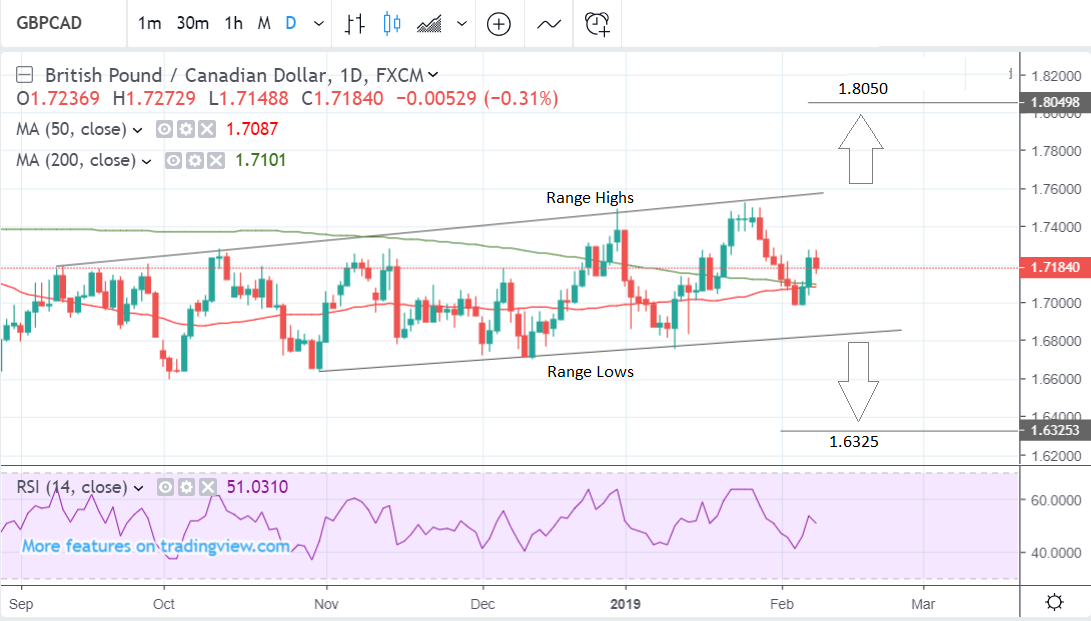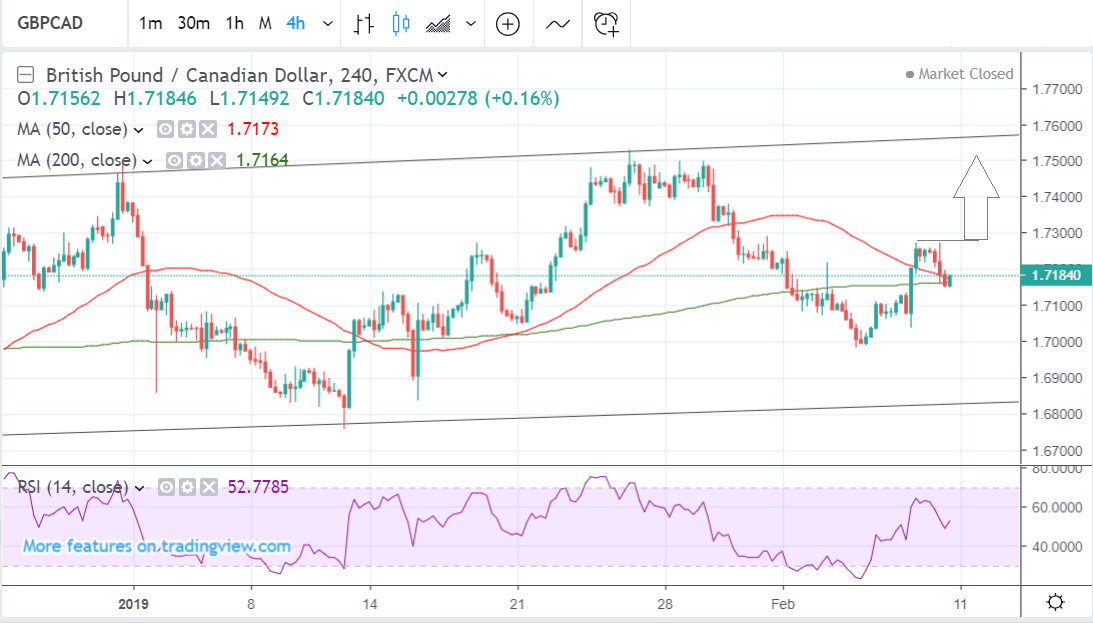The Pound-to-Canadian-Dollar Rate in the Week Ahead: Locked into a Range-bound Market
 Image © COSPV, Adobe Stock
Image © COSPV, Adobe Stock
- GBP/CAD to remain locked in multi-month sideways trend.
- Only a break above or below range would signal new direction.
- GDP and Brexit dominate GBP as CAD takes cues from oil prices.
The Pound-to-Canadian Dollar rate is set for more range-bound trading during the week ahead as oil prices dominate the narrative around the Loonie while the Brexit saga and GDP data are front and centre for Sterling.
The rate was trading at 1.7184 on Monday after rising 0.35% in the previous week. The pair rose mainly as a result of Canadian Dollar weakness after the price of crude oil, the country’s main export, tumbled. The Pound, meanwhile, was little changed on Brexit quagmire.
GBP/CAD has been trading in a tight sideways range since August last year and it is currently trading right in the centre of that range. It is generally extremely difficult to accurately forecast sideways trending markets so our technical stance is neutral.

Above: Pound-to-Canadian-Dollar rate shown at daily intervals.
If the pair breaks out of the range - either higher or lower - of course, the neutral stance will change because it will probably signal the start of a new trend in the direction of the break. At the very least it would suggest an extension to a target generated by the breakout move.

Above: Pound-to-Canadian-Dollar rate shown at daily intervals.
The target for an upside breakout is probably at 1.8050, whilst the target for a downside breakout is somewhere around 1.6325. A break above 1.7625 would confirm a breakout higher whilst a move below 1.6775 would probably confirm a bearish breakout.
Looking more closely at the activity within the range it is possible to see the start of a new up-move after the pair fell to the level of the 50 and 200-week MAs and reversed. This new move higher could evolve some more but it is still too early to be sure.

Above: Pound-to-Canadian-Dollar rate shown at 4-hour intervals.
This is not a confidence call, but a break above the 1.7273 highs would suggest the onset of a new cycle higher, up towards the range highs at 1.76.
The strong rising momentum in the lower pane is another sign that the pair may be about trend higher. It is at the same level it was at when the exchange rate was in the 1.75s. This suggests possible ‘pent-up’ bullish potential.
l
The Canadian Dollar: What to Watch
There is little domestic data of note out of Canada in the coming week for the so the Loonie (the nickname for CAD) will probably take its cue from changes to the price of oil. If oil rises, CAD will gain a boost and vice versa if oil falls.
Oil is Canada’s largest export so changes in its price often impact on the supply and demand of its currency. Last week’s decline came amidst fears the trade war between the U.S. and China would escalate as time is running out to successfully find a resolution before the March 1 deadline, after which the U.S. is set to raise tariffs from 10% to 25% on $200bn worth of Chinese imports.
It is thought that if tariffs rise it will trigger an even deeper global and Chinese slowdown and part of the response will be a reduction in the demand for crude oil. Yet others say oil prices could actually rise due to the possibility of a merger between OPEC and Russia to officially form OPEC+, which would give the cartel even more power in controlling the price of oil.
OPEC+ is expected to officially form at a meeting this February and if the new merger also agrees more widespread supply constraints in order to drive up oil prices, the price of oil could pivot higher.
There are opponents to the OPEC+ merger, including Iran which is afraid of being supplanted in second place by Russia, and the U.S., which is also against such a merger because it would consider OPEC+ a monopoly which would go against its anti-trust legislation.
Whilst Canada is a member of neither OPEC nor the Russia alliance and so would not be included in OPEC +, a general rise in the price of crude might also infect the price of Canadian crude and also push it up, and this would be bullish for CAD.
l
The Pound: What to Watch this week
Brexit remains the key driver for Sterling with the currency being a function of the markets expectation for a 'deal'or 'no deal' Brexit.
Markets are currently confident a deal, of some sort, will be achieved, hence the Pound's outperformance during 2019.
Weekend news is constructive in this manner amidst news the government has sought to buy Prime Minister Theresa May more time to put together a workable Brexit deal by promising MPs another say by the end of the month, as business leaders said the process was now in the “emergency zone”.
Communities secretary James Brokenshire has said that if no finalised deal were put to the Commons by 27 February, MPs would again be given an amendable motion to consider. This would give them the chance to block a 'no deal' departure or make other interventions.
Markets will likely focus on the prospect of parliament being given another shot at blocking 'no deal', we believe this should prove supportive to Sterling.
May will make a statement to parliament on February 13 updating lawmakers on her progress so far in seeking changes to her deal. The debate on February 14 will be on a motion — a proposal put forward for debate - about Brexit more generally. However, because May is clearly engaged in negotiations with the EU, parliament is expected to give the PM more space and votes of significance will only likely be expected later in the month, in line with Brokenshire's guidance.
The main data release for Sterling is Q4 and December GDP data out at 9.30 GMT on Monday, February 11.
The data will provide investors with further hard evidence of how Brexit uncertainty, as well as the global slowdown, is affecting the UK economy.
“So far, we have seen only mixed signals from the economy, although the more up-to-date PMI data suggests businesses and individuals are delaying their purchasing plans as the Brexit debate enters crucial stage with the March 29 exit date fast approaching,” says Fawad Razaqzada, a market analyst at Forex.com.
Current market expectations are for GDP to slow to 1.4% compared to a year ago (from 1.5% in Q3) and to rise 0.2% compared to the previous month of November. A deeper slowdown might have a temporary short-term negative effect on Sterling but it could also focus minds on avoiding a hard-Brexit and, therefore, ultimately have a positive impact on the Pound, if it reduces the chances of ‘no-deal’.
“On top of this, Brexit will remain in focus as a desperate UK Prime Minister Theresa May struggles to renegotiate the withdrawal agreement with the EU leaders,” adds Razaqzada.
Also released at 9.30 on Monday morning are Manufacturing Production data, with the headline expected to show a rise by 0.2% in December, Industrial Production, which is forecast to rise 0.2% and Business Investment, which is expected to rise by 0.2% quarter-on-quarter in Q4.
Inflation data out on Wednesday at 9.30 will be of interest. Usually, it is important for the Pound but this time it may be overshadowed as Theresa May could be making another major Brexit updating speech on that day.
“UK CPI will also be released on Wednesday. Although important, in the grand scheme of things, not many people will pay much attention to it because of Brexit, as mentioned above. Anyway, headline CPI is expected to have eased to +1.9% from +2.1% previously while core CPI is expected to have remained unchanged at +1.9%,” says Forex.com’s Razaqzada.
Time to move your money? Get 3-5% more currency than your bank would offer by using the services of foreign exchange specialists at RationalFX. A specialist broker can deliver you an exchange rate closer to the real market rate, thereby saving you substantial quantities of currency. Find out more here.
* Advertisement





